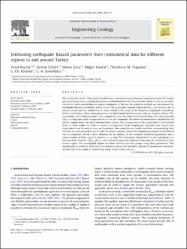Estimating earthquake hazard parameters from instrumental data for different regions in and around Turkey

Göster/
Erişim
info:eu-repo/semantics/closedAccessTarih
2009Yazar
Bayrak, Y.Öztürk, Serkan
Çınar, H.
Kalafat, D.
Tsapanos, T. M.
Koravos, G. Ch.
Leventakis, G-A.
Erişim
info:eu-repo/semantics/closedAccessÜst veri
Tüm öğe kaydını gösterÖzet
We conducted a study of the spatial distributions of seismicity and earthquake hazard parameters for Turkey and the adjacent areas, applying the maximum likelihood method. The procedure allows for the use of either historical or instrumental data, or even a combination of the two. By using this method, we can estimate the earthquake hazard parameters, which include the maximum regional magnitude Mˆ max, the activity rate of seismic events and the well-known bˆ value, which is the slope of the frequency-magnitude Gutenberg- Richter relationship. These three parameters are determined simultaneously using an iterative scheme. The uncertainty in the determination of the magnitudes was also taken into consideration. The return periods (RP) of earthquakes with a magnitude M?m are also evaluated. The whole examined area is divided into 24 seismic regions based on their seismotectonic regime. The homogeneity of the magnitudes is an essential factor in such studies. In order to achieve homogeneity of the magnitudes, formulas that convert any magnitude to an MS-surface scale are developed. New completeness cutoffs and their corresponding time intervals are also assessed for each of the 24 seismic regions. Each of the obtained parameters is distributed into its respective seismic region, allowing for an analysis of the localized seismicity parameters and a representation of their regional variation on a map. The earthquake hazard level is also calculated as a function of the form ?=(Mˆ max,RP6.0), and a relative hazard scale (defined as the index K) is defined for each seismic region. The investigated regions are then classified into five groups using these parameters. This classification is useful for theoretical and practical reasons and provides a picture of quantitative seismicity. An attempt is then made to relate these values to the local tectonics.

















